UK small business statistics 2025
We’ve collated the latest UK small business statistics for 2025, including the number of SMEs in the UK, the evolution of the SME market, and what this means for the average profit margins of small businesses across the country.

Small and medium-sized enterprises (SMEs) are an integral part of the UK economy. Representing more than 99% of all UK businesses, they employ around three in every five workers across the country and contribute more than half towards total business turnover from the private sector.
Like many other businesses, SMEs have faced uncertain economic times in recent decades, marked by financial recessions, the global COVID-19 pandemic, and a cost-of-living crisis.
With this in mind, Money.co.uk has compiled the latest small business statistics for 2025 to illustrate the current economic landscape for SMEs in the UK, how these trends have evolved, and suggest what the future may hold for these cornerstones of the UK economy.
Top 10 must-know UK small business statistics for 2025
There are approximately 5.49 million SMEs in the UK, accounting for more than 99% of all businesses.
The number of small businesses in the UK grew by almost 23% between 2010 and 2024.
Construction has more SMEs than any other UK industry, at 870,000.
London has the most SMEs of all UK regions relative to its population (1,367 per 10,000 adults).
SMEs employ around 60% of the UK workforce.
Roughly 15% of UK SMEs are led by women.
Around 7% of UK SMEs are led by a managerial team where at least half are from an ethnic minority background.
SMEs contribute more than 50% of the total UK business turnover in the private sector, amounting to £2.75 trillion.
The median average revenue for a small business in the UK is £295,000.
The average profit for a UK small business is £70,000 per year.
Number of SMEs in the UK
How many small businesses are there in the UK?
According to the latest UK business statistics, there were almost 5.5 million private sector businesses in the UK as of 2024. The overwhelming majority of these (99.2%) are classed as micro/small businesses (i.e. those with 0 to 49 employees).
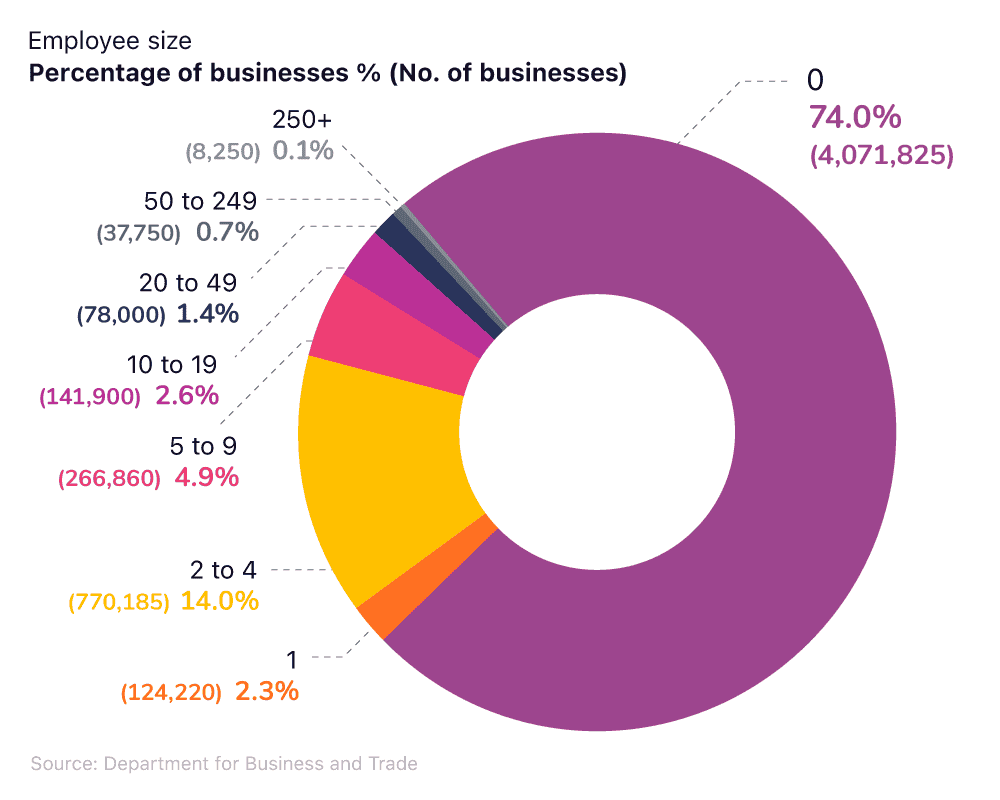
Small business stats from the UK government indicate that almost three-quarters of UK companies have zero employees, with around a seventh having between two and four people on their books.
The growth in the number of UK SMEs
The number of small businesses in the UK grew year-on-year between 2010 and 2020, increasing by a third across the decade to a peak of almost six million.
Number of UK SMEs over time
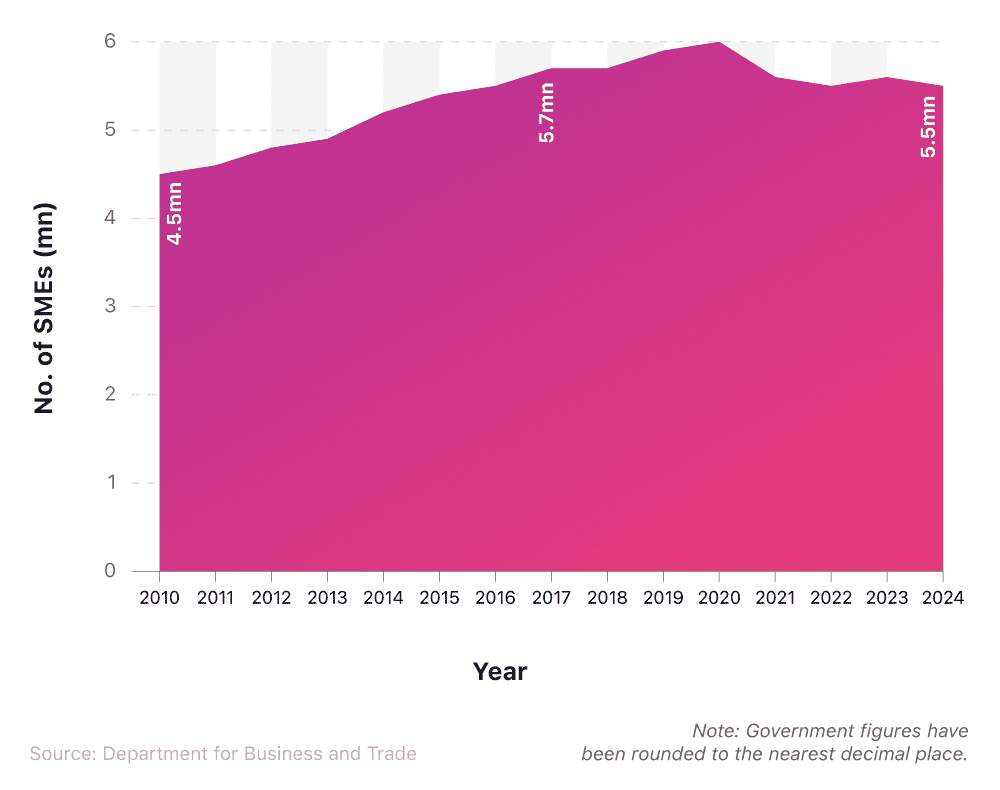
Since the COVID-19 pandemic, the number of SMEs in the UK has fluctuated between 5.5 and 5.6 million.
Number of UK SMEs with employees over time by size of business
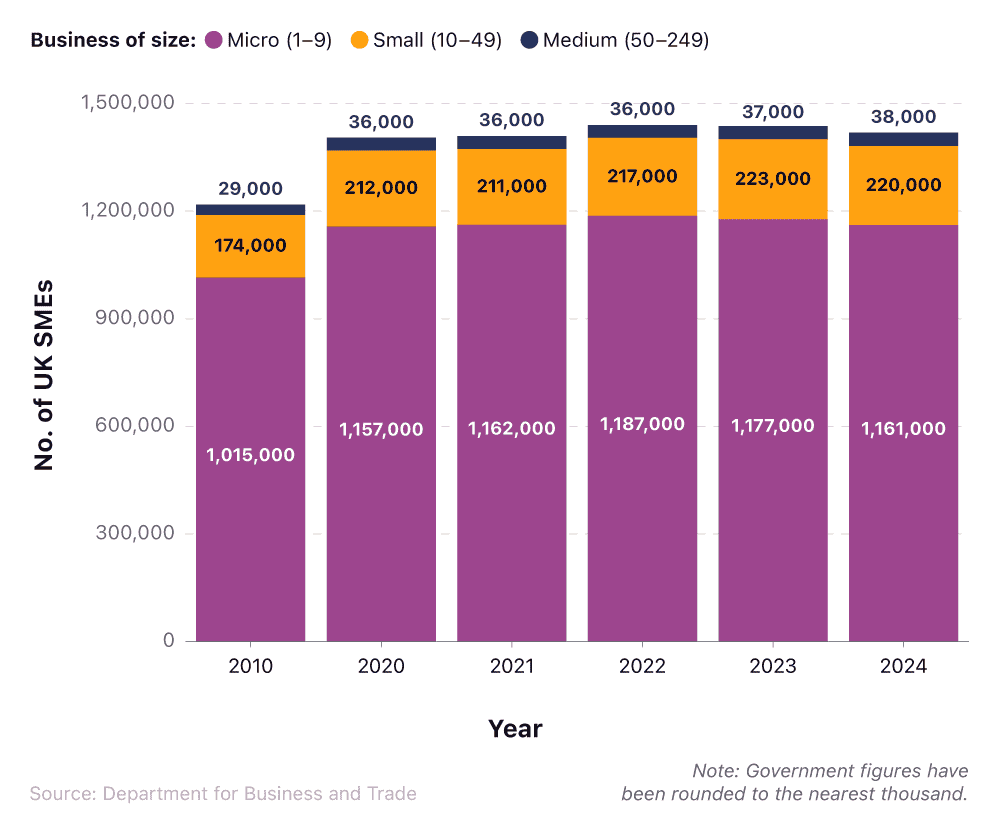
Small business statistics from the Department for Business and Trade reveal that, between 2010 and 2024, the number of:
Micro businesses grew by around a seventh (+14.4%)
Small businesses increased by more than a quarter (+26.4%)
Medium-sized businesses expanded by almost a third (+31.0%)
Which industries have the most SMEs in the UK?
The most recent small business report from the UK government indicates that the construction industry has the highest number of SMEs of any sector.
At almost 870,000, this represents nearly a sixth of the UK’s total number of SMEs and is more than double the number for other service activities.
Number of SMEs in the UK by industry
| Industry | 0 (no employees) | 1 to 49 | 50 to 249 | Total |
| Construction | 676,134 | 191,441 | 1740 | 869,315 |
| Professional, scientific, and technical activities | 566,205 | 183,450 | 3775 | 753,430 |
| Wholesale and Retail trade; Repair of motor vehicles and motorcycles | 314,121 | 238,106 | 5030 | 557,257 |
| Administrative and support service activities | 366,999 | 122,828 | 4457 | 494,284 |
| Other service activities | 299,137 | 67,986 | 367 | 367,490 |
| Human health and social work activities | 292,828 | 58,352 | 4270 | 355,450 |
| Information and communication | 261,569 | 73,334 | 2366 | 337,269 |
| Transportation and storage | 265,859 | 45,040 | 1564 | 312,463 |
| Education | 276,710 | 21,194 | 597 | 298,501 |
| Arts, entertainment, and recreation | 251,523 | 27,760 | 841 | 280,124 |
| Manufacturing | 160,176 | 79,224 | 5923 | 245,323 |
| Accommodation and food service activities | 68,487 | 139,519 | 3393 | 211,399 |
| Agriculture, forestry and fishing | 96,543 | 50,711 | 444 | 147,698 |
| Real estate activities | 91,291 | 51,003 | 429 | 142,723 |
| Financial and insurance activities | 61,849 | 22,827 | 1034 | 85,710 |
| Mining and quarrying; Electricity, gas and air conditioning supply; Water supply; Sewerage, waste management, and remediation activities | 21,983 | 8477 | 435 | 30,895 |
(Source: Department for Business and Trade)
Conversely, there were just under 31,000 SMEs in the mining and quarrying industry as of 2024. This represented the smallest number across all sectors (less than 0.6% of all SMEs in the UK).
Percentage of UK SMEs per industry
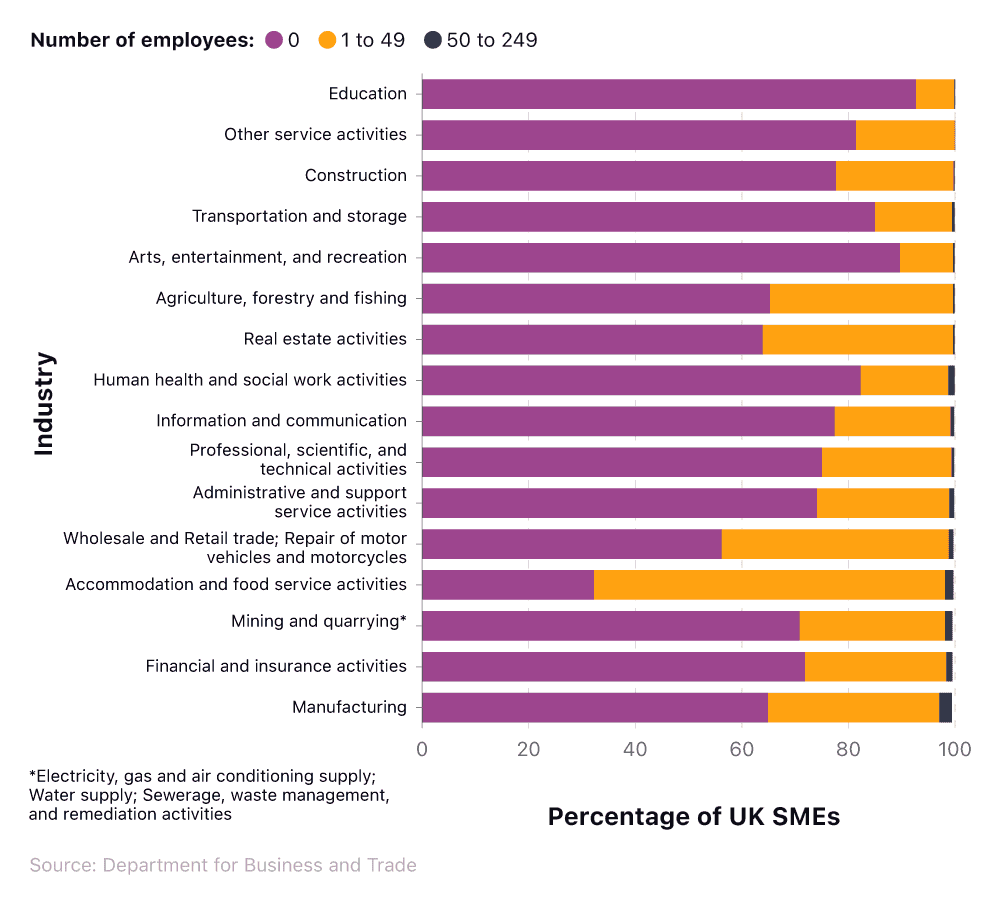
According to the latest small business stats from the UK government. 100% of companies from the education sector and other service activities in 2024 were classed as SMEs.
Their data suggests that:
More than nine in 10 businesses from the education industry had zero employees compared to less than one in three from accommodation and food service activities.
Almost two-thirds of those employed in the accommodation and food service sector were for companies with one to 49 registered workers. This was contrasted with less than one in 14 for education and less than one in 10 for arts, entertainment, and recreation jobs.
SMEs in manufacturing with 50 to 249 employees account for almost 2.5% of the UK total in this sector. This is double the proportion of similarly sized companies in the human health and social work sector and nearly five times more than those in the transport and storage industry.
Number of SMEs in the UK by region
According to small business statistics from the Department for Business and Trade, London has the highest number of SMEs in relation to its population, with 1,367 per 10,000 adults.
This is almost twice as many as the rate for the North East. London was also the only UK region to register more than 1,000 small businesses with zero employees per 10,000 adults in 2024.
Number of small businesses in each region of the UK per 10,000 adults
| Region/country | No. of adults | 0 (no employees) | 1 to 49 | 50 to 249 | Total |
| United Kingdom | 55.19mn | 738 | 250 | 7 | 995 |
| England | 46.53mn | 764 | 257 | 7 | 1,028 |
| Wales | 2.58mn | 637 | 209 | 5 | 852 |
| Scotland | 4.56mn | 571 | 202 | 6 | 778 |
| Northern Ireland | 1.52mn | 615 | 252 | 7 | 874 |
| North East | 2.21mn | 565 | 180 | 5 | 750 |
| North West | 6.11mn | 574 | 228 | 7 | 810 |
| Yorkshire and the Humber | 4.51mn | 626 | 227 | 6 | 859 |
| East Midlands | 4.04mn | 644 | 233 | 7 | 884 |
| West Midlands | 4.86mn | 647 | 235 | 6 | 888 |
| East of England | 5.20mn | 745 | 263 | 7 | 1,015 |
| London | 7.17mn | 1,013 | 345 | 10 | 1,368 |
| South East | 7.63mn | 916 | 263 | 7 | 1,186 |
| South West | 4.79mn | 851 | 255 | 6 | 1,112 |
(Source: Department for Business and Trade)
The North East registered the fewest number of small businesses in 2024 compared to its population (750 per 100,000 adults).
In all, the South East and South West have almost double the number of SMEs as the North East and North West (2,298 vs 1,560 respectively).
Percentage of UK SMEs by region
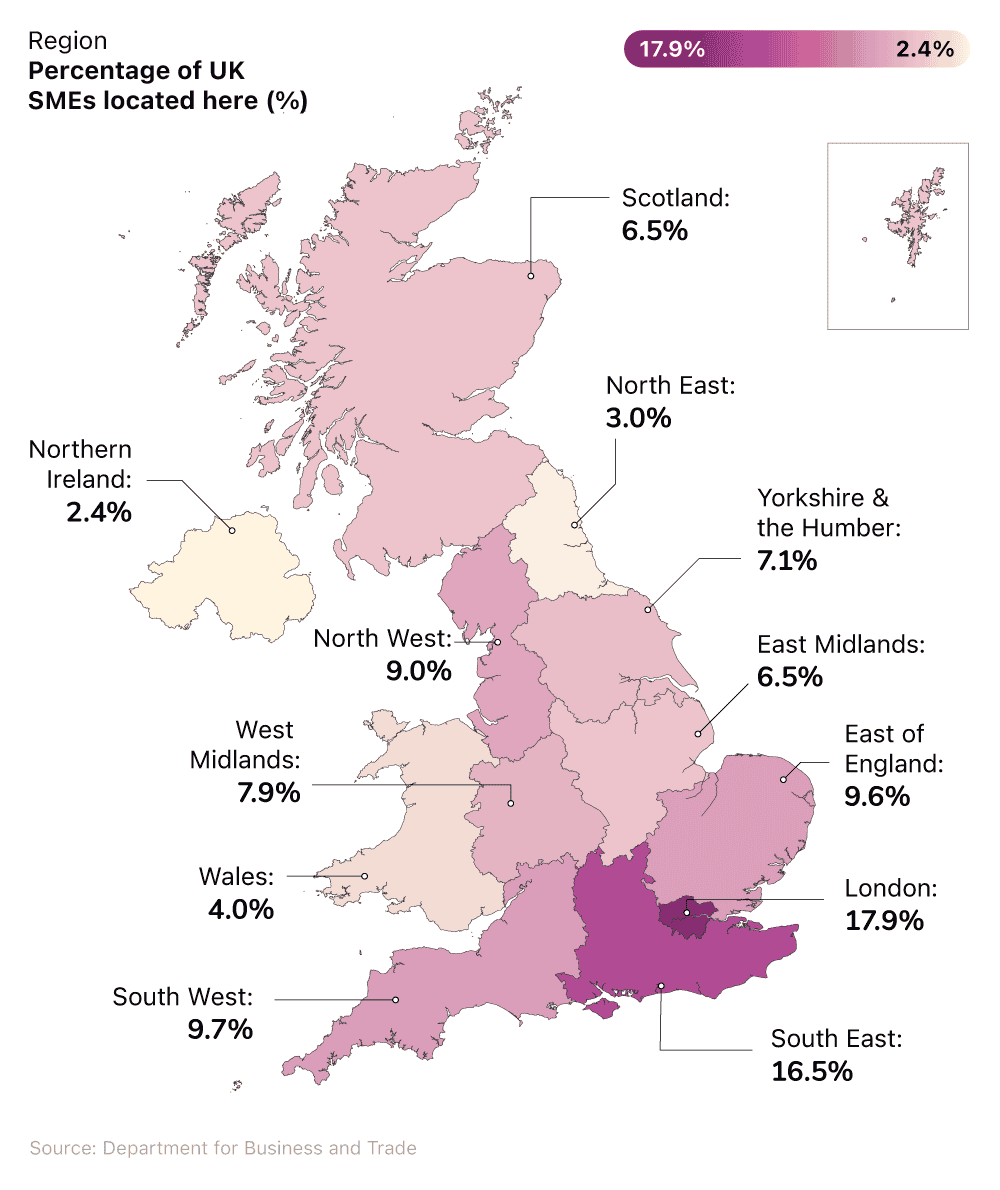
London has the largest proportion of the UK SMEs, occupying more than a sixth of the overall total and almost double the percentage compared to the North West.
At the other end of the scale, just 2.4% of the UK’s SMEs are based in Northern Ireland, making it the smallest proportion across all regions.
Data from the Department for Business and Trade also shows that:
Almost one in ten UK SMEs is found in the East of England, less than half the proportion found in the capital.
London and the South East host close to two-fifths of the UK SME population.
SMEs are more than twice as likely to be found in the South East and South West of England than in the North West and the North East (26.2% vs. 12%, respectively).
Percentage of UK SMEs located in urban vs. rural areas

When broken down by setting, almost seven in 10 SMEs across the UK are based in an urban area, compared to around three in 10 which are found in a rural environment.
UK SME population statistics
How many people are employed by small businesses in the UK?
In all, SMEs employ three-fifths of the UK’s workforce.
Just under 4.5 million people work for SMEs with no employees on their books (i.e. people who run their own business). This accounts for over a sixth of the UK’s total workforce, the largest proportion across all SME employee sizes.
Number of people employed by UK SMEs by business size
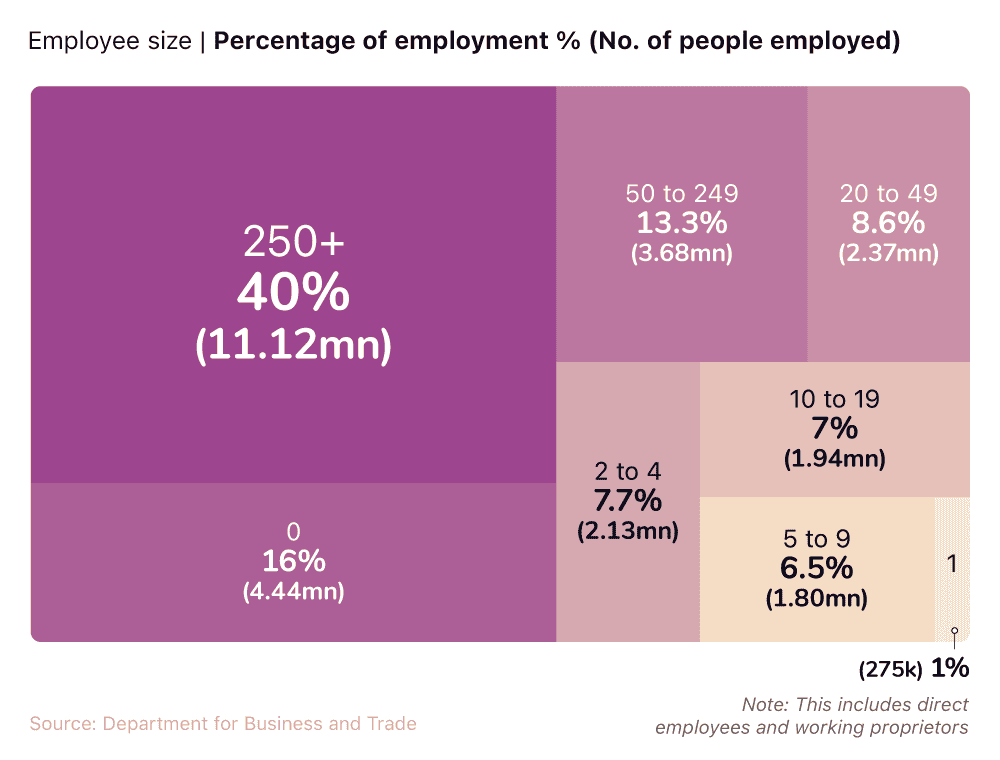
This is followed by those with 50 to 249 workers, who employ less than a seventh of the overall total.
Number of people employed by UK SMEs over time by business size
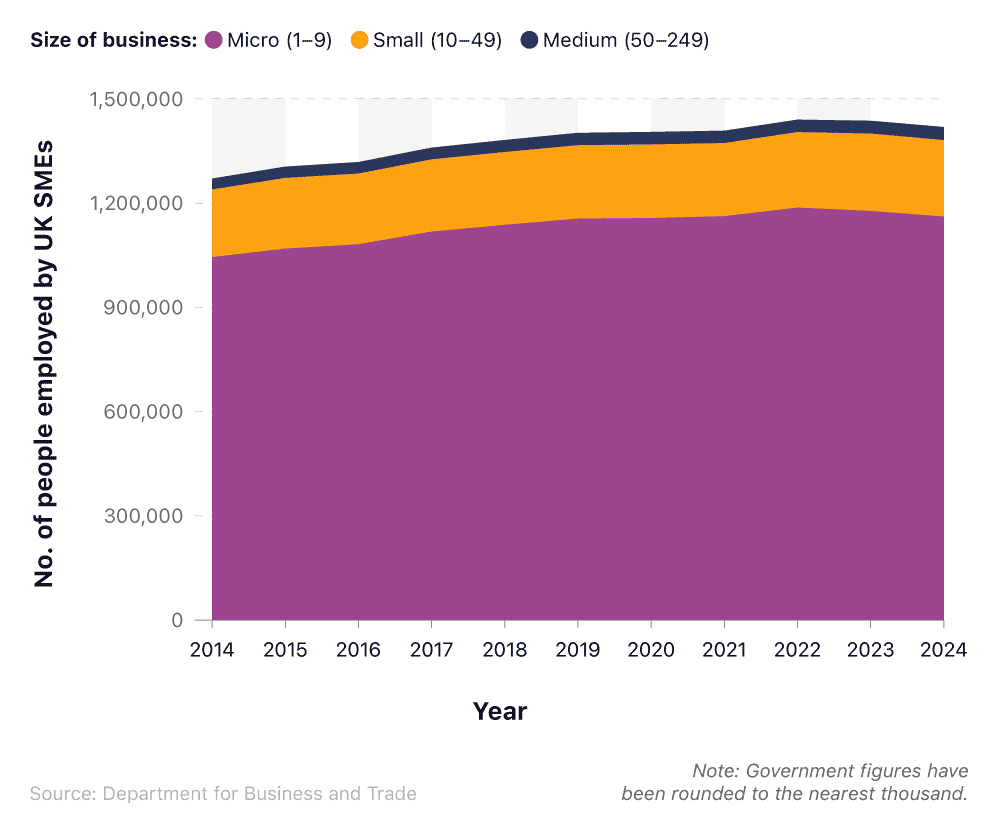
Small business statistics from the Department for Business and Trade reveal that, between 2014 and 2024, the number of people employed by:
Micro businesses grew by more than a tenth (+11.2%)
Small businesses increased by around an eighth (+12.9%)
Medium-sized businesses expanded by a fifth
Women in SME statistics
According to the latest diversity in business statistics, approximately 15% of SME employers are led by women. This was a drop of three and four percentage points, respectively, from 2022 and 2021.
Findings from the Small Business Survey also indicate that a quarter of UK SMEs had an equal management team of men and women in 2023, a slight rise compared to previous years (23% in 2022 and 24% in 2021).
Incidentally, those entirely led by men remained at 44% between 2021-23.

The Rose Review 2023 also found that:
Approximately 150,000 SMEs were founded by women across the UK in 2022 (double the number compared to 2018).
Just over a fifth (20.5%) of new incorporations were all-female-led (a rise from 16.7% in 2018).
The biggest increase was among those aged 16 to 25, with 22 times more businesses being launched by women in this demographic than in 2018.
Four in five women surveyed did not feel confident about the UK’s future economic growth, while 46% weren’t confident about how their business would perform.
Almost half of those questioned believed fundraising would become more difficult with time.
An estimated £250 billion could be added to the UK economy if women started and scaled businesses at the same rate as men.
Did you know? Start-up business loans are a great way to kickstart your business, provide a financial boost for your company, and help scale your SME with confidence.
Ethnic diversity statistics in UK SMEs
Latest results from the UK’s Small Business Survey show that in 2023, around 7% of SME employers were led by a management team where at least 50% were from an ethnic minority group. This represents a slight increase from 2022, when the figure stood at 6%, but one which has remained largely unchanged since 2015.
Ethnic diversity of UK SMEs
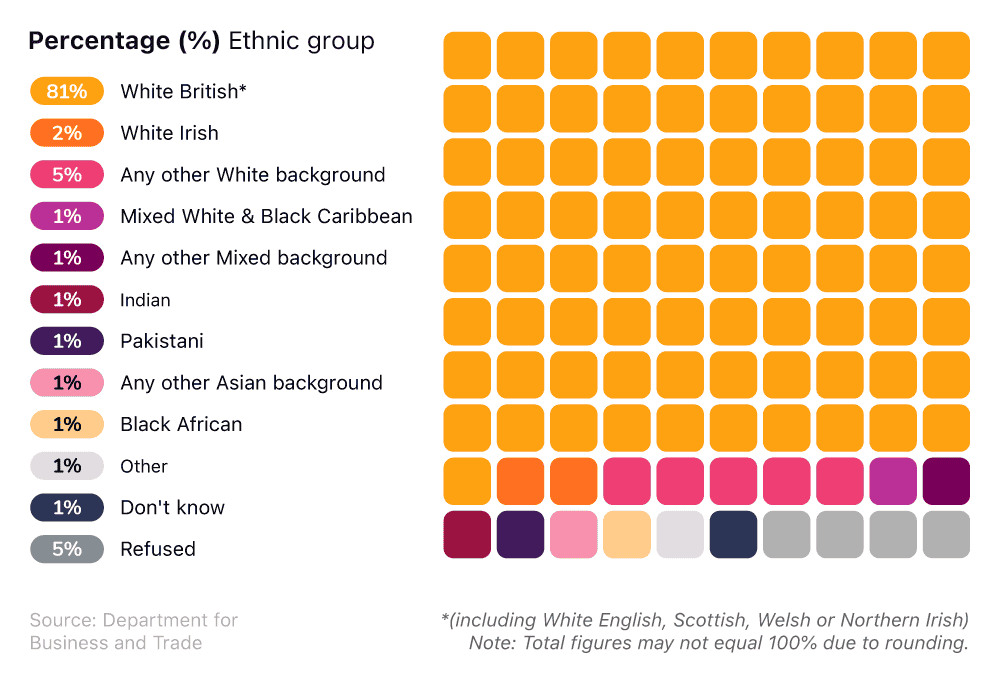
The latest available government figures show that, as of 2021, there were just over 1.5 million White SME owners in the UK. This figure fluctuated between 2012-21, reaching a peak of almost 1.9 million in 2017. Since then, the number has fallen year-on-year, representing a decrease of more than a fifth in the space of five years.
Conversely, between 2012 and 2021, the number of SME owners in the UK from other ethnic groups rose:
Black/African/Caribbean/Black British background increased by four-fifths
Chinese ethnicity doubled
Indian origin increased by 17%
Mixed/multiple ethnic groups more than doubled, from 9,000 to 23,000, within a decade
The estimated percentage of SME business owners in the UK among different ethnic groups
| Ethnic group | 2012 | 2013 | 2014 | 2015 | 2016 | 2017 | 2018 | 2019 | 2020 | 2021 |
| Any other Asian background | 0.8 | 0.8 | 0.7 | 1 | 1 | 1.2 | 0.9 | 1.1 | 1 | 1.3 |
| Bangladeshi | 0.4 | 0.4 | 0.3 | 0.3 | 0.4 | 0.7 | 0.4 | 0.5 | 0.6 | 0.3 |
| Black/African/Caribbean/Black British | 1.1 | 1 | 1.3 | 1.4 | 1.3 | 1.7 | 1.7 | 1.7 | 2.1 | 2.1 |
| Chinese | 0.3 | 0.3 | 0.3 | 0.5 | 0.6 | 0.8 | 0.7 | 0.7 | 0.5 | 0.7 |
| Indian | 2.7 | 2.8 | 2.9 | 2.6 | 3 | 2.7 | 3.1 | 3.1 | 3.7 | 3.2 |
| Mixed/multiple ethnic groups | 0.5 | 0.6 | 0.8 | 0.6 | 0.8 | 1 | 0.9 | 1.2 | 1.5 | 1.3 |
| Other ethnic groups | 1.5 | 1.1 | 1.5 | 1 | 1.5 | 1.6 | 1.5 | 1.9 | 1.2 | 1.7 |
| Pakistani | 1.5 | 1.1 | 1.3 | 1.6 | 1.5 | 2 | 1.5 | 1.7 | 1.1 | 1.2 |
| White | 91.1 | 91.8 | 90.7 | 91 | 89.8 | 88.3 | 89.5 | 88 | 88.4 | 88 |
(Source: ONS)
As of 2013, more than nine in 10 UK SMEs were owned by a member of the white population.
By 2021, this figure had dropped by 3.8 percentage points.
In the space of 10 years, ONS data reveals that the proportion of UK SMEs owned by people identifying as:
Black/African/Caribbean/Black British almost doubled (1.1% vs. 2.1%)
Indian rose by 1.5 percentage points
Mixed/multiple ethnic groups almost tripled (0.5% vs. 1.3%)
UK small business revenue and profit statistics
UK SMB market statistics
At the start of 2024, there were 5.45 million small businesses in the UK (i.e. those with 0 to 49 employees). This accounted for 99.2% of all companies across the country, three-fifths of all private sector employment, and more than half of turnover from that segment.
In the same year, total UK SME employment figures stood at 16.6 million, with an estimated turnover of £2.8 trillion.
By comparison, the number employed in small businesses with fewer than 249 employees was around 13 million, with a total turnover of £1.8 trillion. This represented 47% and 35% of their respective total figures across all UK businesses.
What is the average revenue for a small business in the UK?
According to small business statistics from the Department for Business and Trade, the median average revenue (turnover) for a UK SME in 2023 stood at £295,000, with the mean average almost 4.5 times higher at £1.3 million.
Average revenue for small businesses in the UK
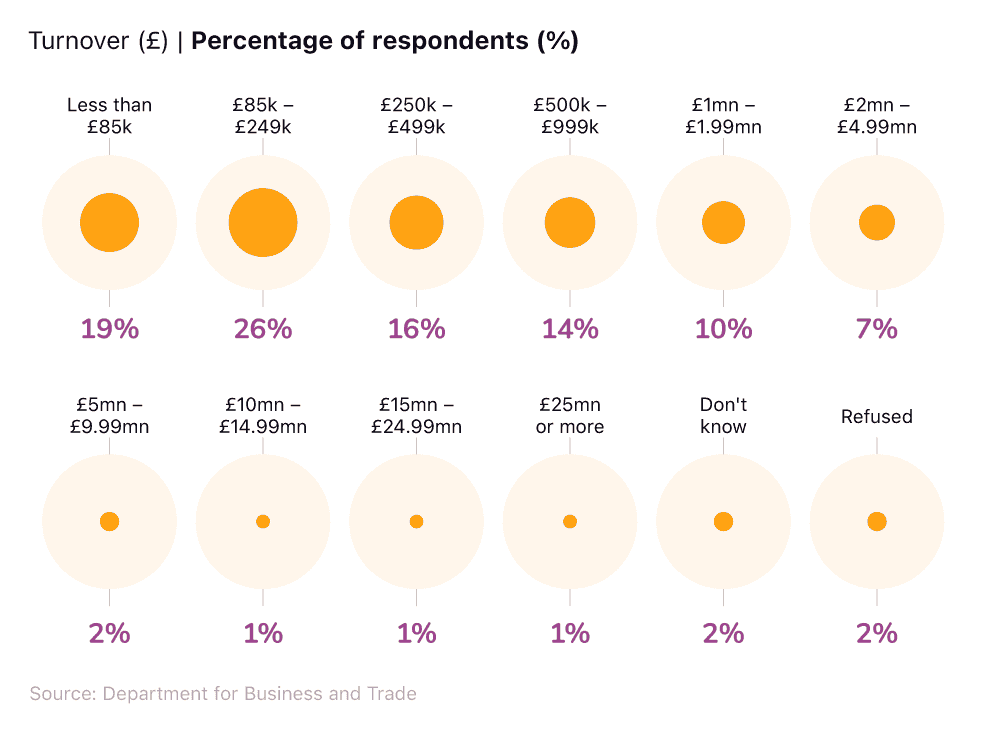
The UK Government’s 2023 Small Business Survey reveals that more than a quarter of SMEs earned between £85k and £249k throughout the year, almost double the proportion for those earning between £500k and £999k.
Generally speaking, as the average amount of turnover increases, the percentage of SMEs earning that amount tends to decrease, with just 3% of UK SMEs reporting an average revenue of more than £10 million throughout 2023.
How has the average revenue of small businesses in the UK changed over time?
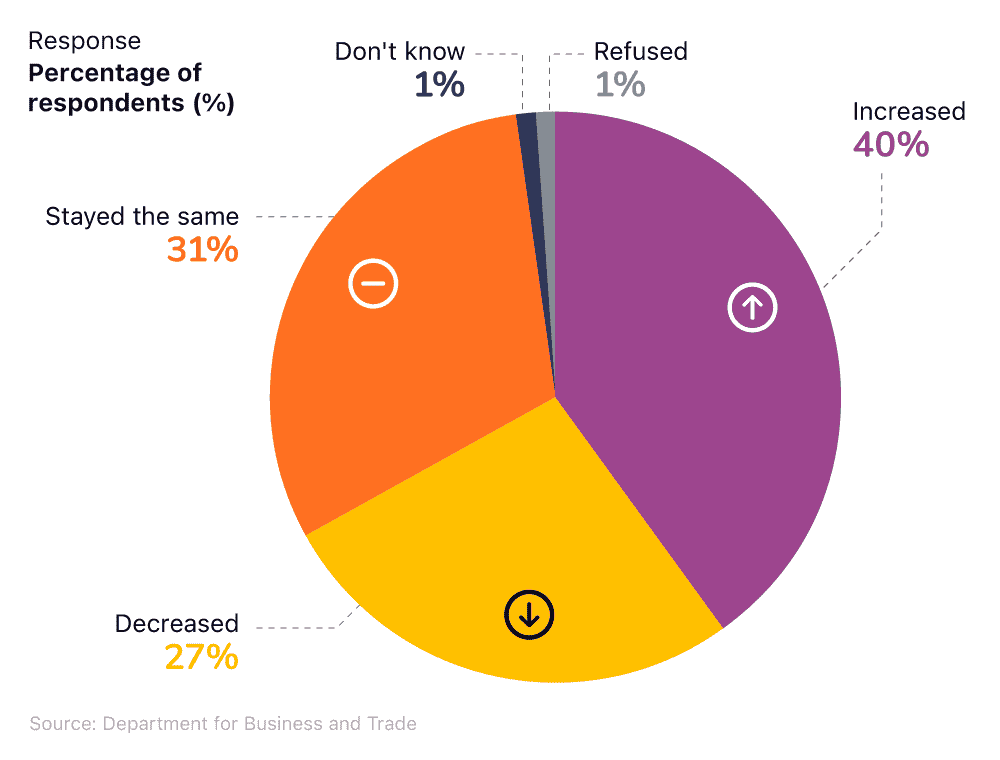
Two-fifths of SMEs surveyed by the Department for Business and Trade noted that their average revenue had increased over the previous 12 months.
More than a quarter noted the opposite, with just under a third claiming their revenue figures remained largely the same between 2022 and 2023.
Contribution of SMEs to total business turnover in the UK
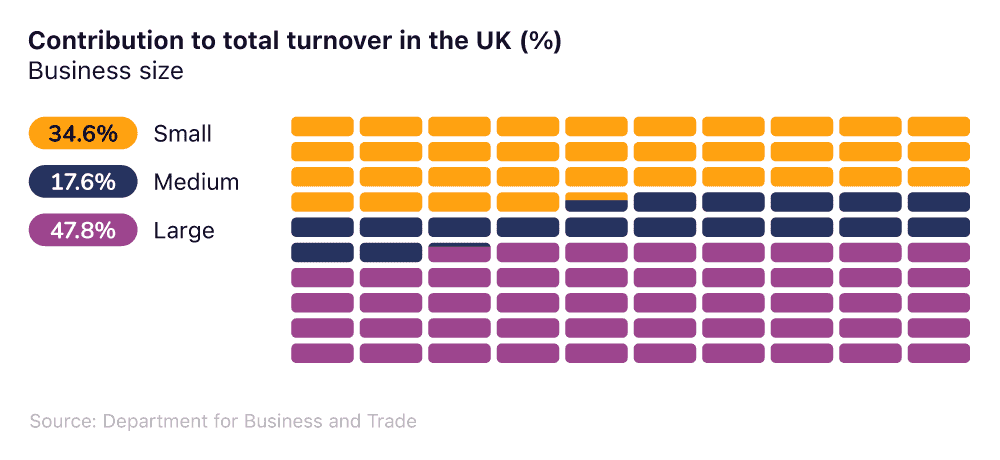
As of 2024, small businesses with fewer than 50 employees contributed more than a third towards total business turnover in the UK, almost double the proportion from medium-sized businesses with 50 to 199 employees.
Incidentally, just under half of UK business revenue for the year came from large corporations.
UK SME turnover statistics by business size
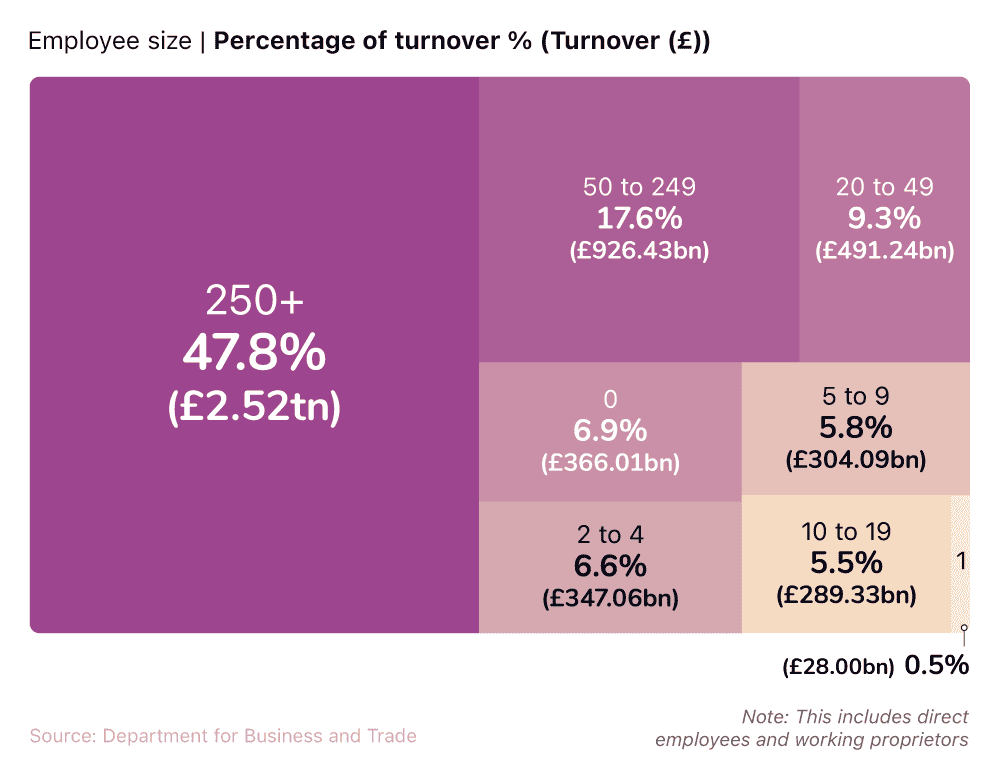
According to small business stats from the UK government, SMEs contributed more than half (52.2%) towards total business turnover in 2024, to the tune of around £2.75 trillion.
Of the total generated by UK businesses in 2024, less than a fifth came from companies that employed between 50 and 249 people (more than double the contribution from those with zero employees).
What is the average profit for a small business in the UK?
The average profit for a small business in 2024 stood at £70,000.
Generally speaking, as the number of employees within a business increases, so does the typical profit it makes.
Median average profit for SMEs in the UK (2024)
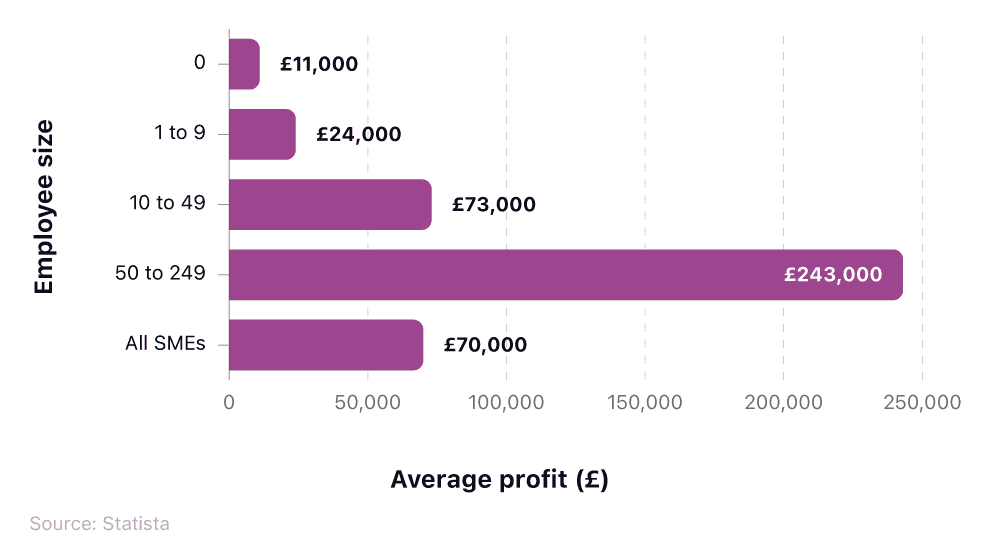
On average, those with one to nine employees usually turn over a profit that is double the amount of those with none.
Likewise, companies with 50 to 249 workers typically earn more than triple the average profit compared to those with 10 to 49.
What is the average profit margin for a small business in the UK?
As of Q2 2024, the average profit margin for a small business in the UK stood at 8.8%. This represented a drop of 1.9 percentage points from Q1 2023, when the figure stood at 10.7%.
The net rate of return percentage for UK businesses over time
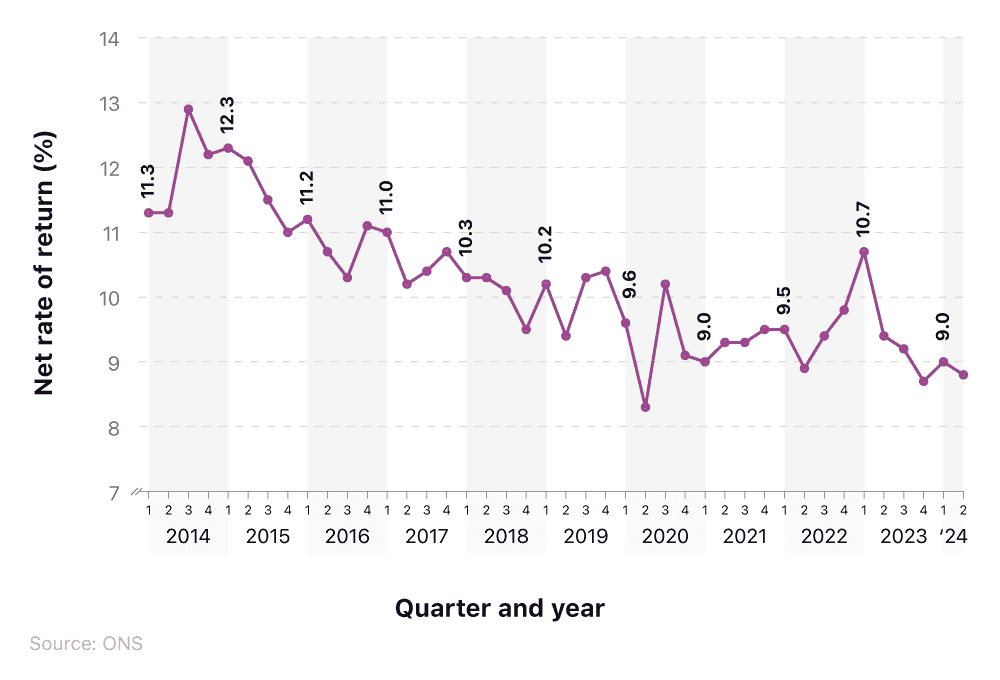
Since Q1 2014, the net rate of return percentage for UK businesses has fluctuated, from a low of 8.3% in Q2 2020 (during the start of the COVID-19 pandemic) up to a high of 12.9% in Q3 2014. This reflects a difference of 4.6 percentage points within just under six years.
Did you know? You can help grow your SME with a business savings account, allowing you to earn interest, plan, and build a cushion that helps support the sustainable growth of your company.
UK small business expenditure statistics
Average monthly rent for a small business in the UK
According to a study by Real Business Rescue, London has the highest average rent for retail space across all towns and cities in the UK. At £49.64 per square foot a year (or £4.14 per month), this is around 0.3% greater than the typical cost for retail space in Oxford.
The most and least expensive areas in the UK for average retail rental prices
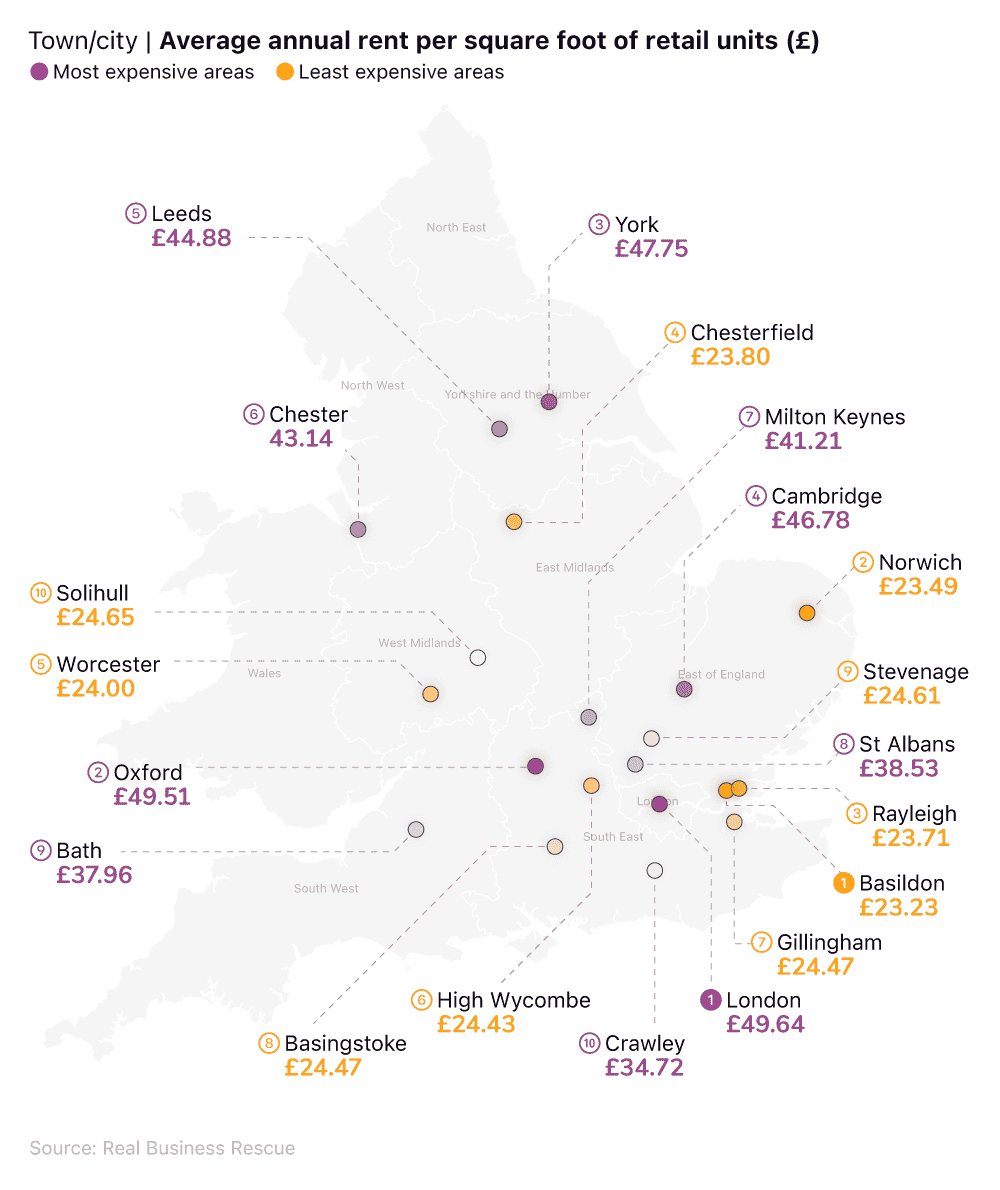
At the other end of the scale, Basildon recorded the lowest average rent for businesses from those included in the study. With typical retail rental costs of £23.23 per square foot per year (or £1.94 per month), this makes it more than half the average cost faced by those situated in the capital.
The same can be said for Norwich, Rayleigh, and Chesterfield, which all recorded average rental costs of less than £24 per square foot per year for retail space.
Average cost of small business insurance in the UK
Our latest business insurance statistics report found that more than half of UK SMEs stopped buying at least one form of business insurance cover in 2023. The most common reasons for this were that their business was too small (47%) or they now work from home (42%).
Research by Aviva also found that 17% of SMEs potentially don’t have employers’ liability insurance (a legal requirement for firms that employ people).
In 2024, the average cost of employers’ liability insurance in the UK was around £61 for a single office worker, rising to £213 for manual labourers.
The average energy bill for a small business in the UK
The average energy use for SMEs in the UK can vary depending on the size of the business and whether you’re referring to electricity and/or gas consumption.
For example, as of 2025, a micro business (one with zero to nine employees) typically uses around 15,000 kWh of electricity and 10,000 kWh of gas a year. For the average small business (i.e. those with between 10 and 49 workers), the increase is approximately two-thirds for electricity and more than doubles for gas.
Average energy consumption for UK small businesses
| Business size | Average electricity consumption | Average gas consumption |
| Micro | 15,000 kWh | 10,000 kWh |
| Small | 25,000 kWh | 25,000 kWh |
| Medium | 50,000 kWh | 45,000 kWh |
| Large | >50,000 kWh | >65,000 kWh |
(Source: Bionic Services Limited)
These figures then practically double again once you become a medium-sized business and start employing 50 to 249 people.
By contrast, large corporations can be expected to use >50,000 kWh of electricity and >65,000 kWh of gas per year (over three times the amount of electricity and more than six times the gas consumption of a micro business, by comparison).
The average cost of energy for a small business in the UK
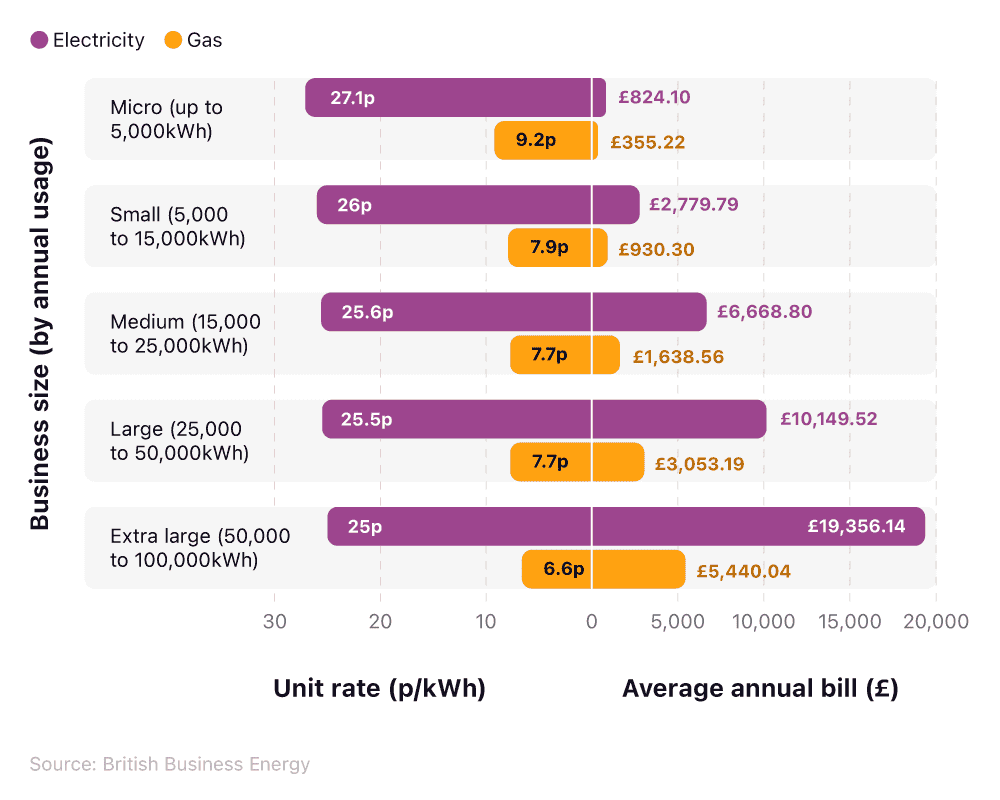
The average cost of energy for UK SMEs varies depending on the size of your business, how much energy you typically use, and the resulting rate you’re on.
Generally speaking, larger corporations using more than 50,000 kWh tend to have lower tariffs than smaller businesses for both electricity and gas. For example, a micro business can expect an electricity unit rate of 27.1p/kWh and 9.2p/kWh for gas. This is around 8.4% and 39.4% more than the respective rates for an extra-large company.
As of 2025, the average electricity bill for a UK small business using 5,000 to 15,000kWh stood at £2,779.79. This was around triple the cost compared to a micro business using up to 5,000kWh and almost 2.5 times less than a medium-sized company using 15,000 to 25,000kWh of energy.
Similarly, the average gas bill for a UK small business in 2025 (i.e. one in which uses between 5,000 and 15,000kWh) was £930.30 (approximately triple the amount a standard micro business using up to 5,000kWh would pay and just under half the typical cost faced by medium-sized corporations using between 15,000 and 25,000kWh).
Compare business gas quotes to see if you can switch and save money on your energy bills.
Proportion of total business costs for small businesses that are spent on gas bills
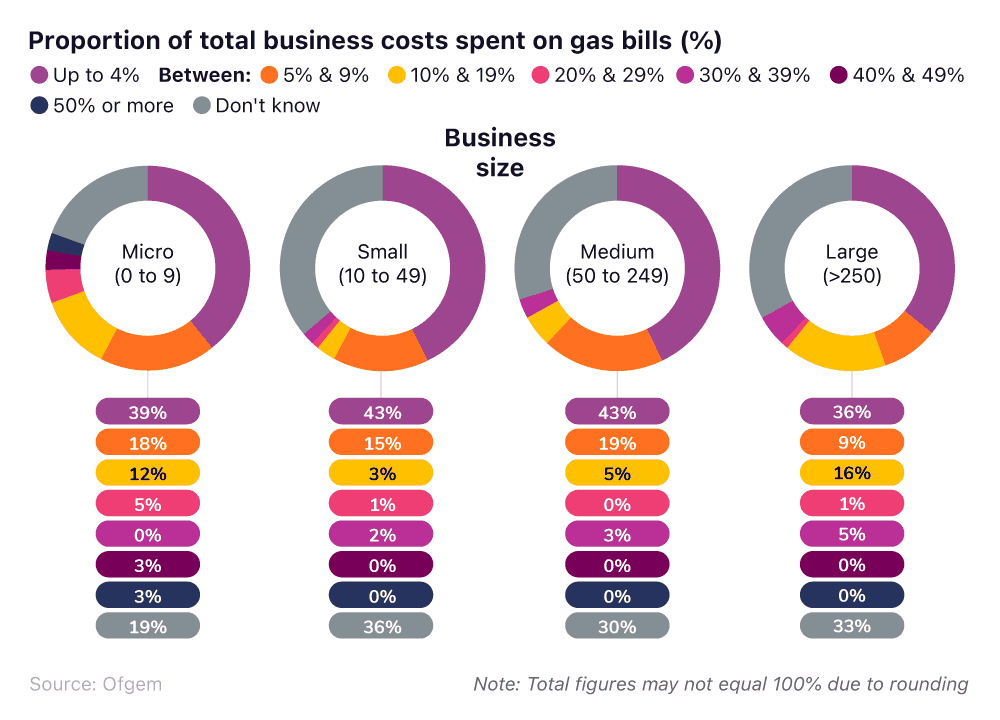
(Source: Ofgem)
According to Ofgem, more than two-fifths of small businesses spend less than 4% of their total business costs on gas bills, with almost a sixth facing gas costs between 5% and 9% of their overall expenditure.
In total, almost seven in ten UK small businesses spent less than 20% of their total outgoings on gas consumption in 2024.
Incidentally, more than a third of small business owners surveyed by Ofgem claimed not to know how much they spend on gas—the highest percentage across all business sizes.

| undefined | Micro (0 to 9) | Small (10 to 49) | Medium (50 to 249) | Large (>250) |
| undefined | undefined | undefined | undefined | undefined |
| Up to 4% | 30% | 33% | 30% | 16% |
| Between 5% and 9% | 22% | 17% | 18% | 19% |
| Between 10% and 19% | 11% | 9% | 9% | 10% |
| Between 20% and 29% | 7% | 2% | 3% | 4% |
| Between 30% and 39% | 2% | 1% | 2% | 1% |
| Between 40% and 49% | 2% | 1% | 1% | 1% |
| 50% or more | 4% | 2% | 3% | 3% |
| Don't know | 22% | 33% | 33% | 44% |
(Source: Ofgem)
Ofgem’s 2024 Non-domestic Research Report found that a third of UK small businesses spend up to 4% of their total business costs on electricity. An identical percentage were unaware of how much electricity costs their company each year relative to their total business outgoings.
In all, just over three-fifths of small businesses surveyed by Ofgem spent less than 20% of their total business expenditure on electricity in 2024.
Compare business electricity quotes to see if you can switch to a different tariff and save money on your energy bills.
Small businesses’ experiences of the energy market (vs. other-sized companies)
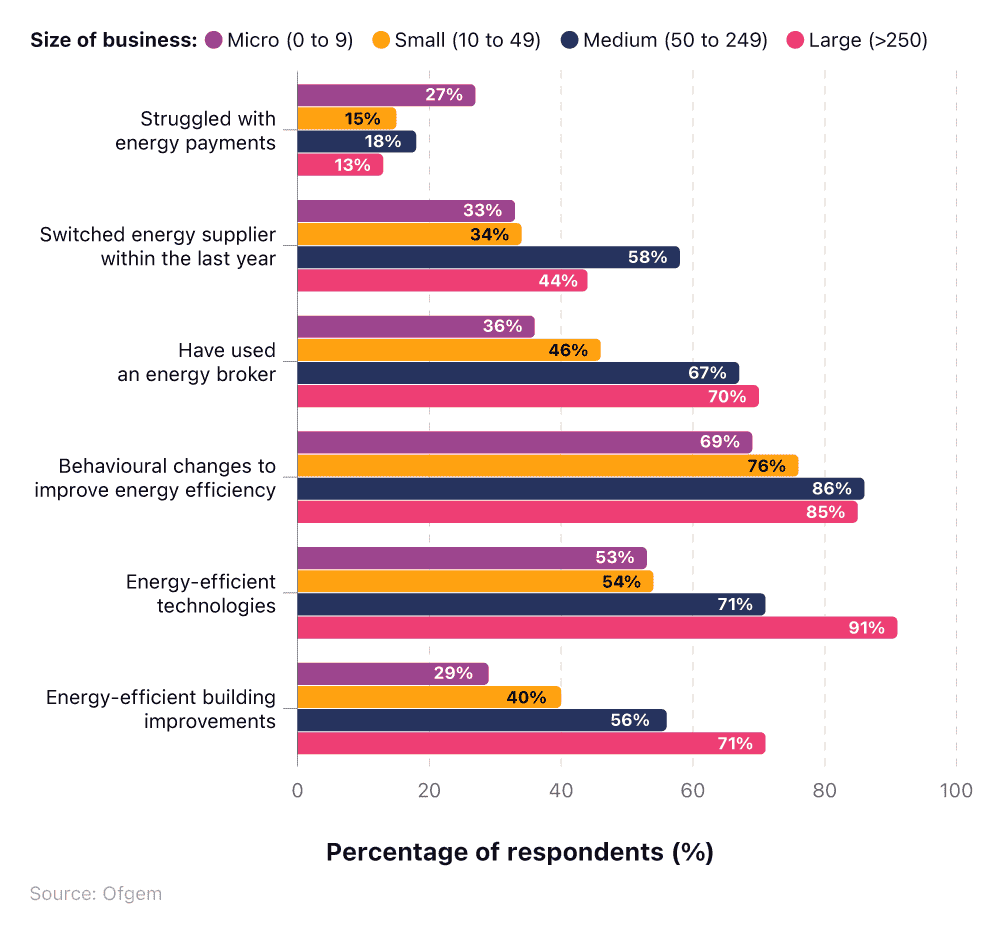
As of 2025, almost one in six UK small businesses claimed to be struggling with their energy payments. In addition, approximately a third admitted that they had switched their supplier within the last year, and just under half had used an energy broker.
Check out our guide on how finance can help SMEs lead on sustainability and develop a long-term, green business model.
Ofgem’s latest report into the UK business energy market also found that:
Smaller businesses tend to struggle more with paying their energy bills than larger corporations. This figure was around double the proportion for micro enterprises compared to large businesses (27% vs. 13%).
Large companies are around twice as likely to use an energy broker as a micro business and almost 2.5 times more likely to make energy-efficient building improvements as part of their business energy strategy.
Around three-quarters of UK small businesses have made behavioural changes within their company to improve energy efficiency, compared to more than four-fifths of medium and large corporations.
Over half of UK micro and small businesses have introduced energy-efficient technologies in a bid to reduce energy consumption and costs, contrasted with nine in 10 large enterprises.
Did you know? A business credit card can be a great way to help save money, boost your cash flow, and unlock rewards that are tailored towards your company’s spending.
What is the average water bill for a small business in the UK?
The average water bill for a UK business in 2025 stood at £5,557.37. However, this may vary depending on the size of your company, how much water you use, and where you’re located in the country.
Average cost of a water bill for UK businesses by provider
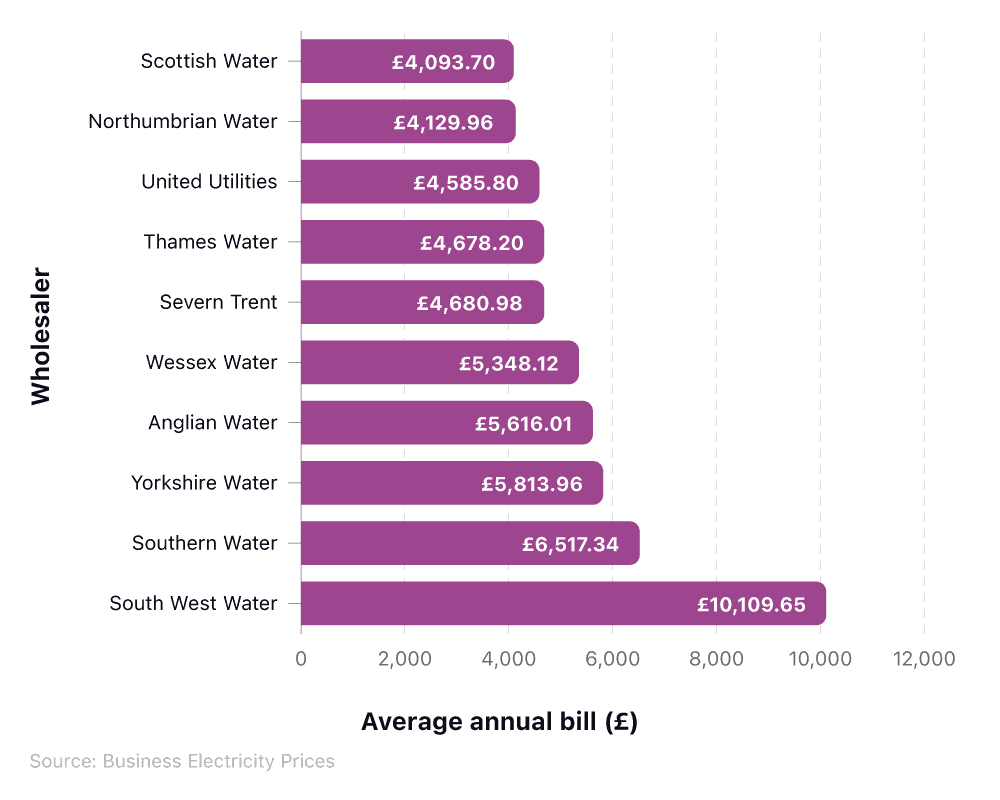
Water wholesalers data in depth
| Wholesaler | Water rate (£/m³) | Waste water rate (£/m³) | Annual fixed charge for waste and water (£) | Average annual bill (£) |
| Scottish Water | £0.90 | £1.61 | £315.05 | £4,093.70 |
| Northumbrian Water | £1.34 | £1.39 | £77.05 | £4,129.96 |
| United Utilities | £1.80 | £1.20 | £78.75 | £4,585.80 |
| Thames Water | £1.94 | £1.17 | £114.60 | £4,678.20 |
| Severn Trent | £1.75 | £1.29 | £103.43 | £4,680.98 |
| Wessex Water | £1.61 | £1.93 | £121.45 | £5,348.12 |
| Anglian Water | £1.69 | £1.97 | £129.81 | £5,616.01 |
| Yorkshire Water | £1.71 | £2.08 | £113.96 | £5,813.96 |
| Southern Water | £1.82 | £2.40 | £138.48 | £6,517.34 |
| South West Water | £3.63 | £3.05 | £176.25 | £10,109.65 |
Scottish Water produced the lowest average cost of water for businesses in 2025, with typical annual charges of just under £4,100. This was around 2.5 times less than companies supplied by South West Water (the most expensive area for business water rates).
Average marketing costs for a small business in the UK
The average marketing costs for a small business in the UK are largely dependent on your total revenue and how established your company is.
For example, new, up-and-coming businesses (i.e. those less than five years old) are likely to spend a greater proportion of their budget on marketing as they seek to build a name for themselves, develop their brand, and gain customer loyalty.
Average marketing budget for UK businesses over time (as a percentage of total revenue)
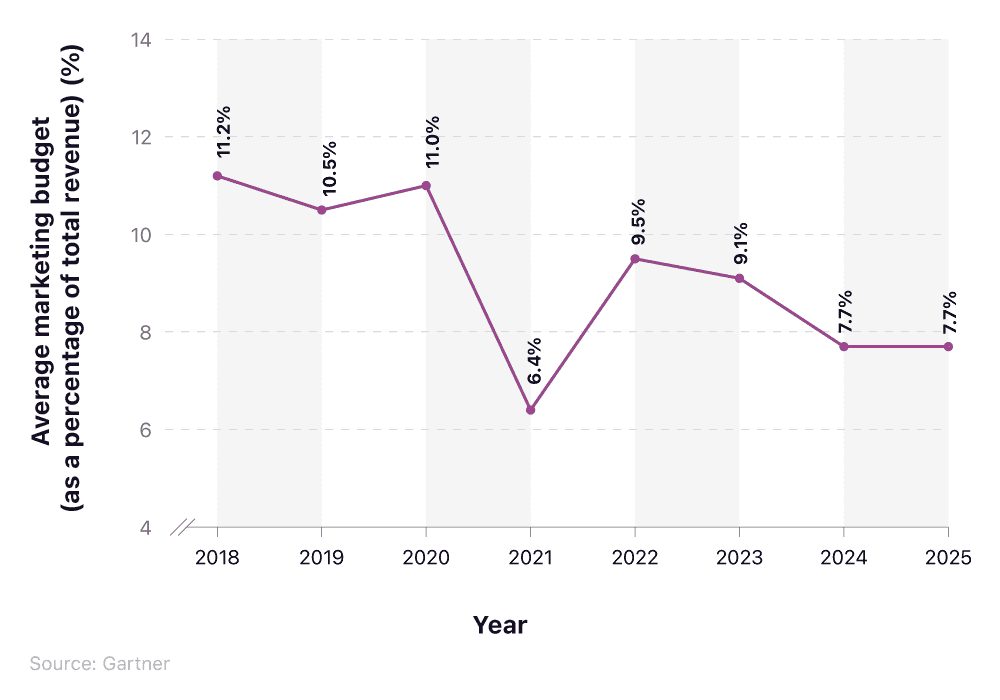
Gartner’s 2025 Marketing Report found that UK businesses spend an average of 7.7% of their total revenue on their marketing budget.
This figure decreased by almost a third between 2018 and 2025, reaching a low of 6.4% in 2021 during the height of the COVID-19 pandemic.
Did you know? 43% of UK microbusinesses use personal current accounts for business banking. As a limited company in the UK, you’re legally required to have a business bank account to manage finances, pay taxes, and issue dividends. You could also look into opening a business savings account to help keep your funds safe while earning interest.
Average small business loan for UK SMEs
According to the latest small business stats from the British Business Bank, SMEs invested £12.31 billion in 2024, with just under half of this coming from companies with 50 to 249 employees.
Average investment by business size
| Business size | Gross Value Added (GVA) (£bn) | Median average investment (as a percentage of GVA) (%) | Total investment (approx. GVA x median) (£bn) |
| 1 to 9 | £263.41bn | 1.14% | £3.69bn |
| 10 to 49 | £199.52bn | 1.44% | £2.87bn |
| 50 to 249 | £219.56bn | 2.62% | £5.75bn |
| Total | undefined | undefined | £12.31bn |
(Source: British Business Bank)
Details from the 2025 Small Business Finance Market Report suggest that SMEs invested a median average of 1.73% in 2024 (as a percentage of their GVA), with this figure increasing in proportion to the size of the business.
Our business loans statistics report also found that the overall value of UK SME bank loans in 2023 reached £59.2 billion. This represented a drop of 9% from the previous year and accounted for approximately 12% of total gross lending for the year to UK businesses.
The latest figures from 2022 indicate that the median average for a small business loan for a UK SME is around £14,000.
Did you know? 63% of SMEs say that taxation is their biggest business barrier. Check out our guide on the impacts of this and what can be done to overcome the taxation challenge for SMEs.
The future of UK small businesses
The 2023 Small Business Report found that almost two-thirds of UK SMEs expect their employee numbers to stay the same going forward.
Expected change to the number of employees in UK small businesses
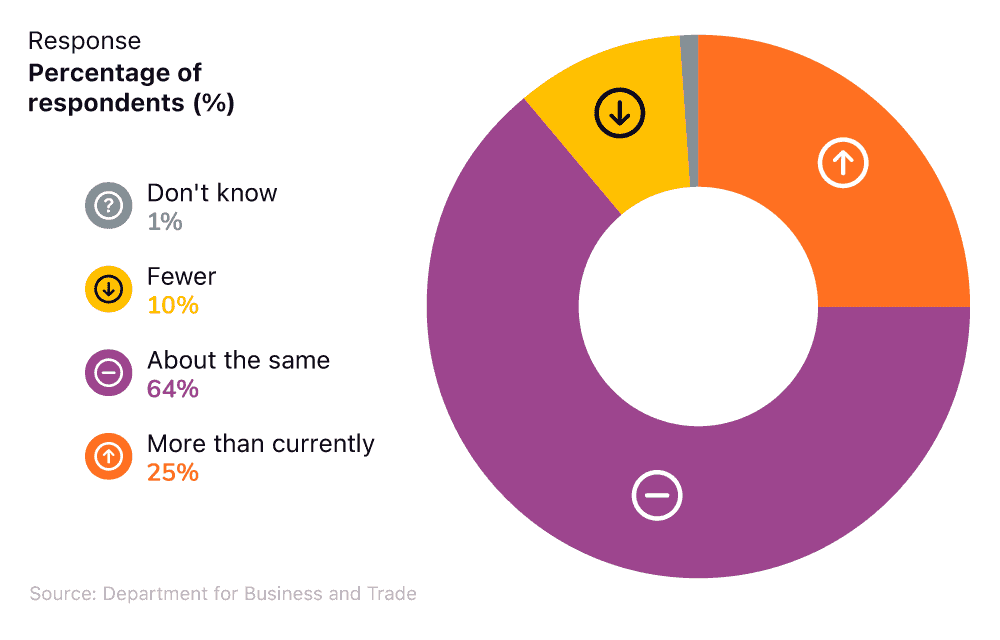
Meanwhile, a quarter of those surveyed by the Department for Business and Trade were looking to employ more people in the future, while one in 10 were looking to make job cuts.
Expected change to average turnover for small businesses in the UK
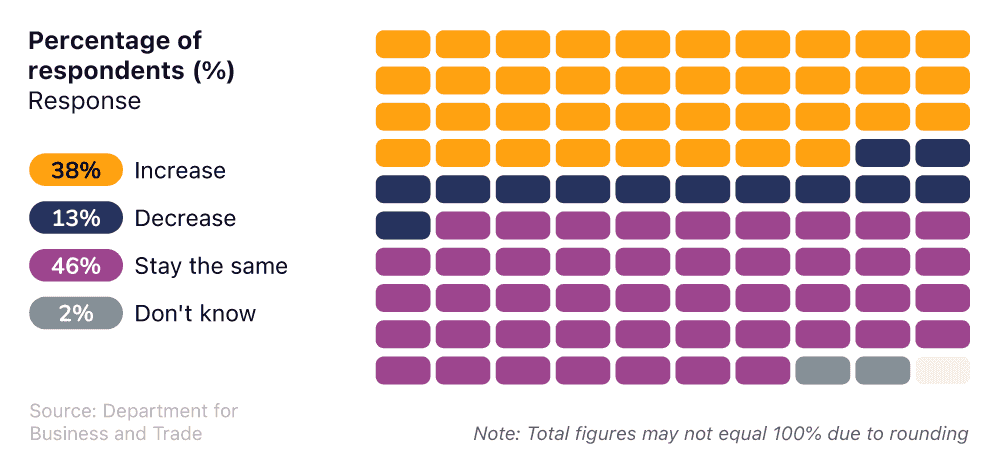
Small business stats from the UK government indicate that more than two-fifths of SMEs expect future growth in sales of between 10% and 24% over the next three years, with a fifth forecasting a rise of up to half.
Interestingly, almost one in 10 of those questioned by the Department for Business and Trade believe sales figures will at least double for their company in the next 36 months.
Expected use of external finance in the future for UK SMEs over the next three years
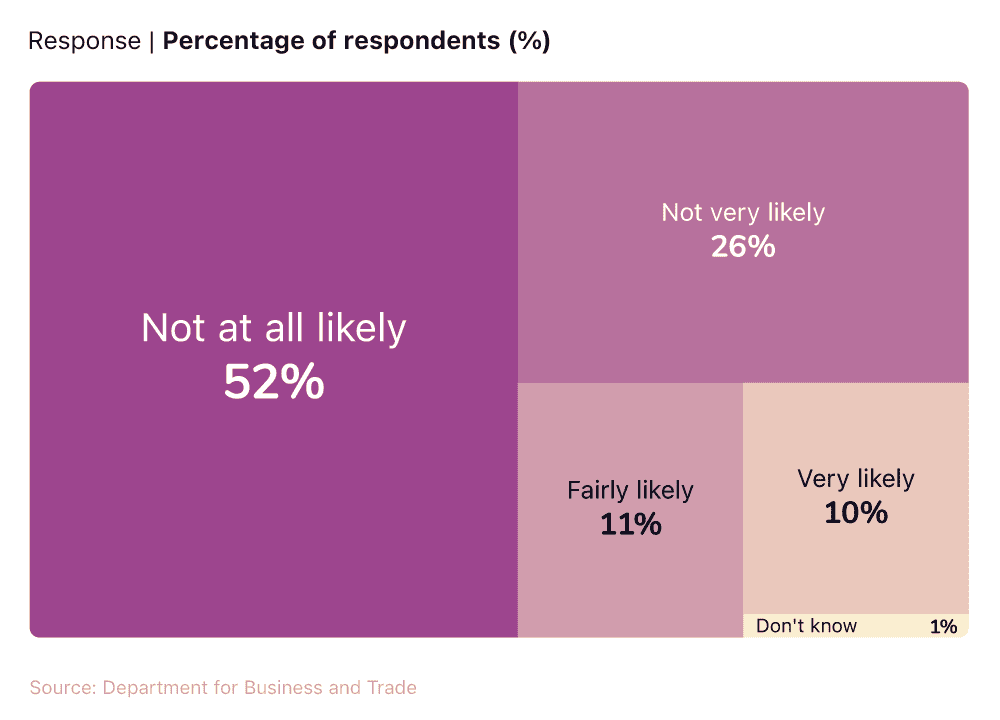
More than three-quarters of SMEs do not expect to use external finance in the future, with just over a fifth of the opinion that they are likely to lean on credit to some degree.
Check out our guide on the UK government’s SME growth plan to see how these changes could impact you and your business, and the potential SME finance challenges you might expect to face in the future.
Small business FAQs
What is an SME business?
An SME business is defined as any organisation with fewer than 250 employees. They should have a turnover of less than €50 million or a balance sheet total no greater than €43 million.¹
How many employees does a micro business have?
A micro business has fewer than 10 employees.
How many employees does a small business have?
A small business has between 10 and 49 employees.
How many employees does a medium-sized business have?
A medium-sized business has between 50 and 249 employees.
Sources and methodology
Sources and methodology
https://www.gov.uk/government/statistics/business-population-estimates-2024
https://www.gov.uk/government/statistics/small-business-survey-2023-businesses-with-employees
https://www.gemconsortium.org/report/gem-united-kingdom-20232024-national-report-2
https://www.fsb.org.uk/media-centre/uk-small-business-statistics
https://www.statista.com/statistics/291299/average-profit-of-smes-in-the-uk-by-enterprise-size/
https://www.realbusinessrescue.co.uk/advice-hub/uk-retail-rental-prices
https://www.statista.com/statistics/1198366/average-annual-cost-employers-liability-insurance-uk/
https://bionic.co.uk/business-energy/guides/average-energy-usage-for-businesses/
https://britishbusinessenergy.co.uk/
https://www.ofgem.gov.uk/publications/non-domestic-2024-research-report
https://www.businesselectricityprices.org.uk/water-prices/
https://www.wordstream.com/blog/ws/2016/10/26/marketing-budget
https://www.gartner.com/en/marketing/topics/marketing-budget
https://www.british-business-bank.co.uk/sites/g/files/sovrnj166/files/2025-02/small-business-finance-market-report-2025.pdf
https://www.gov.uk/government/publications/fcdo-small-to-medium-sized-enterprise-sme-action-plan/small-to-medium-sized-enterprise-sme-action-plan

About Joe Phelan
Joe is an experienced writer, journalist and editor. He has written for the BBC, National Geographic, the Observer, Scientific American and VICE. As a business expert, his work frequently spotlights the ventures and achievements of small business owners. He writes a weekly insight article for money.co.uk, published every Tuesday.
